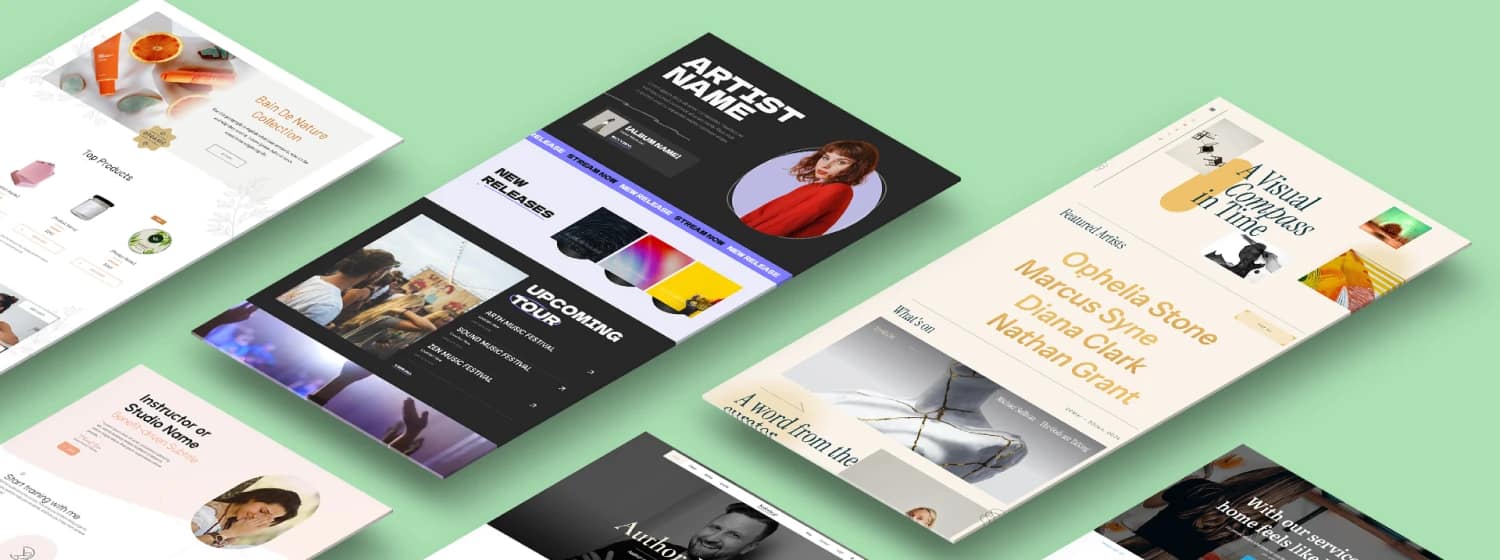TL;DR: How to Hack Time-Based Marketing
If you only take one thing from this guide, let it be this: time isn’t just something you schedule, it’s something you can sell with. When you use time strategically, you don’t just get clicks—you create momentum that compounds into long-term growth.
That’s the snapshot. Now let’s get into the details and unpack how to turn timing into a growth strategy you can trust.
What if the real growth lever in your business isn’t what you sell, but when you sell it?
That thought changed the way I approach marketing. Time isn’t just a calendar to manage—it’s the spark that creates urgency, anticipation, and momentum.
Most people treat timing like logistics: send the email at 9, launch on Friday, post three times a week. I see it differently. Used with intention, time becomes a conversion driver.
In this guide, I’ll show you how to use it that way—from classic calendar campaigns, to real-time marketing, to evergreen scarcity systems that run on autopilot. By the end, you’ll see how to turn timing into a strategy that feels authentic, ethical, and wildly effective.
Frequently Asked Questions About Time-Based Marketing
If you’re new to time-based marketing (or even if you’ve dabbled in it before) it’s easy to get lost in the jargon. Is it just about holiday sales? Does evergreen marketing mean the same thing? And how do you create urgency without feeling manipulative?
To make this guide as practical as possible, I’ve pulled together answers to the most common questions people ask about time-based marketing. Think of this as your quick-reference section: simple explanations, real examples, and clear distinctions that will help you cut through the noise and apply these strategies with confidence.
Time-based marketing is about aligning your campaigns with moments. not just demographics or interests. Instead of only focusing on who your customer is, you focus on when they’re most likely to act.
Unlike broad brand awareness or evergreen content marketing, time-based strategies lean on urgency, scarcity, or timeliness to nudge someone toward a decision in the moment.
Time-based marketing relies on deadlines, limited-time promotions, or timely events to drive conversions.
Evergreen marketing, on the other hand, is designed to work continuously – think timeless blog posts or automated funnels that run year-round. When you combine them (for example, using evergreen content as the entry point and layering in a personal countdown), you get the “evergreen scarcity” effect: urgency on autopilot.
Scarcity taps into three big human motivators: FOMO (fear of missing out), loss aversion (we’d rather avoid losing something than gain it), and the scarcity principle (we value what feels rare).
When a campaign says “only 3 spots left” or “offer ends tonight,” it shifts the decision from “maybe later” to “act now.” Done right, scarcity doesn’t just drive sales—it changes how people perceive value.
Almost every business can benefit, but the tactics look different. Retailers thrive with calendar-driven promotions (think Black Friday). Service providers often use supply-based scarcity (limited client spots).
Course creators and SaaS companies lean into evergreen funnels with personalized deadlines. The key is matching the time-based trigger to your actual business model and customer behavior.
Yes, if it’s fake or overused. Resetting countdowns, endless “flash sales,” or claiming “only 2 left” when stock is unlimited quickly erodes trust. Customers aren’t naive.
When they sense manipulation, they disengage – or worse, they spread skepticism about your brand. Authenticity is non-negotiable if you want time-based tactics to work long term.
The product might be unlimited, but the offer doesn’t have to be. You can limit time-sensitive bonuses (like a free coaching call or live Q&A), restrict early-bird pricing to a short window, or offer “founder’s circle” access to only the first group of buyers.
That way, the urgency is real and believable – even when your core product is evergreen.
Specialized tools like Thrive Ultimatum create personalized countdowns that sync across devices and emails. Paired with evergreen webinar software, automated email platforms, and checkout tools, they ensure that when a deadline expires, it really expires. That tech backbone makes the scarcity authentic instead of a gimmick.
It’s ethical when it’s transparent and based on real limits. If you’re clear about why an offer has a deadline (“I only take 10 clients a month” or “this bonus requires live access to me”), customers see the scarcity as value-driven, not manipulative. The moment you start faking limits, you cross the line from persuasion into deception.
It depends on what you’re selling. Limiting quantity works best for high-status or experiential products (luxury goods, premium programs). Limiting time is effective across the board, especially for digital products. A third option—demand-based scarcity (“selling fast” or “X people booked this today”)—works particularly well for practical, utilitarian purchases.
Start with a timeless asset like a guide, a checklist, or an automated webinar. When someone engages with it, trigger a personal countdown for a related offer—like a discounted course or a bonus add-on. This way, your evergreen content keeps pulling in leads year-round, and each person experiences urgency that feels personal to their timing, not forced.
This is Why Most Businesses Struggle With Time-Based Marketing
Time-based marketing sounds simple—add a deadline, run a seasonal promo, create some urgency. But in practice, most businesses either oversimplify it or overcomplicate it. They confuse different approaches, burn out chasing seasonal spikes, or turn customers off with fake urgency.
Here’s where things usually go wrong:
Common Time-Based Marketing Pitfalls
1. Confusion about what “time-based” really means
Most people lump everything together—holiday promos, real-time tweets, evergreen funnels—and miss the nuance. That confusion creates messy campaigns that don’t feel strategic.
2. Over-reliance on calendar spikes
Black Friday, Valentine’s, Cyber Monday… these work, but they also create unpredictable revenue swings and leave long, flat months in between. Teams burn out prepping for the “big dates” while momentum fizzles the rest of the year.
3. The trap of false urgency
Fake countdowns and endless “limited-time” sales might boost clicks at first, but once customers realize the urgency isn’t real, trust is gone. And when trust goes, so does conversion.
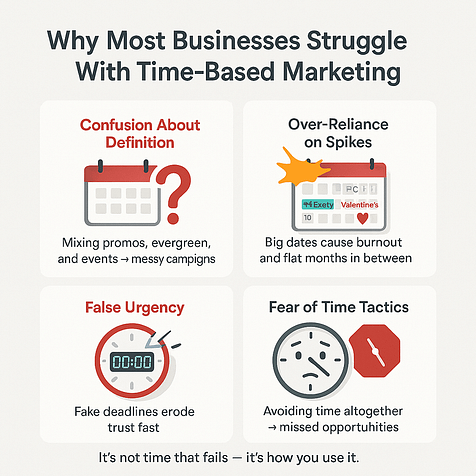
4. Fear of using time at all
On the other side, some businesses avoid time-based tactics completely because they’re afraid of being pushy. The result? Missed opportunities to nudge customers when they’re already paying attention.
The consequence: brands either push urgency so hard it backfires, or avoid it so much they leave money on the table. The problem isn’t time—it’s how we use it.
The Three Core Approaches to Time-Based Marketing
Time-based marketing isn’t one-size-fits-all. There’s a spectrum of approaches, each with its own strengths, blind spots, and best-fit use cases. Some strategies are predictable and calendar-driven, others are reactive and trend-focused, and the most powerful ones are personalized to a customer’s exact moment of decision.
If you only use one end of this spectrum (for seasonal sales, for example) you’ll constantly feel like you’re chasing peaks and valleys. But when you understand all three, you can design campaigns that balance long-term reliability with short bursts of urgency.
Here’s how the three major types break down:
Traditional Time-Based Marketing
Think of this as the calendar approach. It’s the simplest and most familiar form of time-based marketing: tying your campaigns to holidays, seasons, or cultural events.
Examples you already know: Back-to-School sales in August, Valentine’s Day “gifts for your loved one,” or the tidal wave of Black Friday promotions in November.
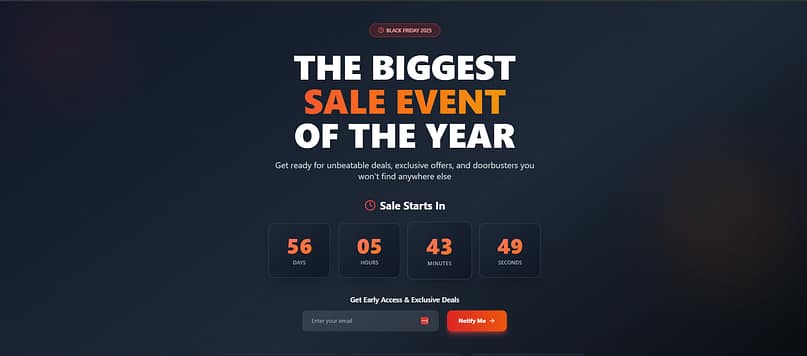
Pros & Cons of Traditional Marketing
Why it works: customers are already in a buying mood. They’re expecting deals, looking for inspiration, and more willing to spend. By aligning with these moments, you meet them where they already are.
What to watch out for: it’s predictable. Every brand in your space is also running sales during these moments, which makes it harder to stand out. It also isn’t personalized—whether you’re a new lead or a loyal repeat customer, the offer looks the same. That makes this strategy powerful in bursts, but weak as a year-round growth engine.
👉 Beginner takeaway: use calendar events as a foundation, but don’t rely on them alone. They’ll give you spikes, not sustainable growth.
Real-Time Marketing (RTM)
Now, this is the agile approach. Instead of planning months ahead, you respond to what’s happening right now—current events, viral trends, or live conversations.
The classic example: during the 2013 Super Bowl blackout, Oreo tweeted “You can still dunk in the dark.” It was witty, relevant, and went viral.
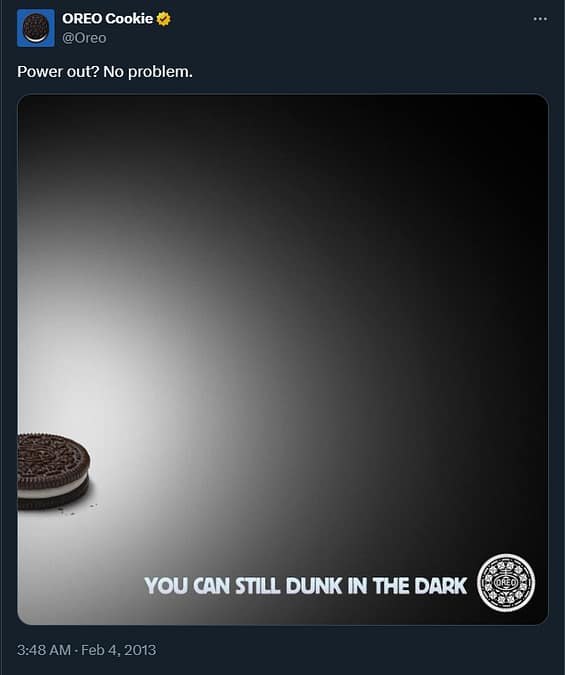
Pros & Cons of Real-Time Marketing
Why it works: it gives your brand visibility and cultural relevance. Done right, it doesn’t feel like advertising—it feels like joining the conversation.
What to watch out for: it’s risky. You need fast decision-making, a bold brand personality, and a team ready to publish in hours, not weeks. Miss the timing and you look slow. Misread the mood and you risk backlash.
👉 Beginner takeaway: real-time marketing can catapult you into the spotlight, but it’s not a sustainable everyday strategy. Think of it as a bonus play, not your main engine.
Right-Time Marketing
This is the smart approach. Instead of tying your campaigns to the calendar or the news cycle, you tie them to your customer’s behavior.
Examples you’ve probably seen:
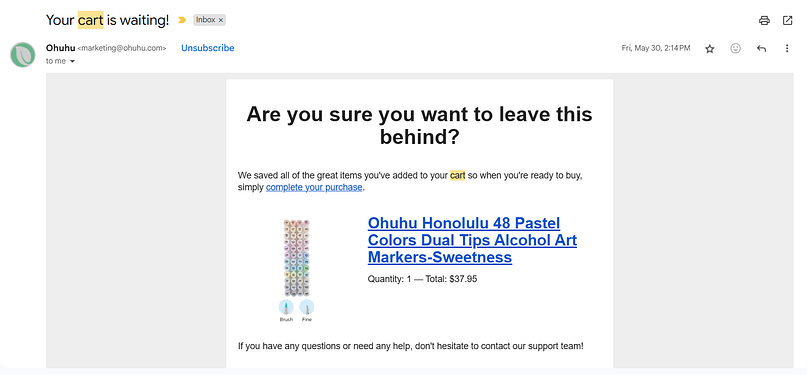
Pros & Cons of Right-Time Marketing
Why it works: it’s personalized. You’re not blasting the same offer to everyone—you’re meeting people at the exact point where they’re most likely to act. That’s why right-time marketing often outperforms the other two.
What to watch out for: it requires data and systems. You need to track behavior, segment your audience, and set up automations that trigger at the right moment. Without that foundation, you can’t scale it.
👉 Beginner takeaway: if you’re new to time-based marketing, this is the approach to grow into. It’s more effort upfront, but it pays off with consistent conversions.
How to Build an Evergreen Scarcity System for Continuous Urgency
Most businesses treat urgency like a switch—turned on during launches or seasonal promos, then flipped off until the next big push. But what if urgency could run in the background every single day, creating steady momentum without feeling forced?
That’s where evergreen scarcity comes in. Instead of relying on fixed calendar dates, you tie urgency to each customer’s personal journey.
This is how you move from unpredictable revenue spikes to a system that generates consistent conversions year-round.
Turn Your Evergreen Content Into an Evergreen Funnel
Evergreen content is the kind of resource you create once and keep reaping rewards from.
Think of a “Beginner’s Guide to Strength Training” in the fitness world, or a “How to Save Money on Taxes as a Freelancer” webinar. These resources solve problems people will always have, so they stay useful and valuable long after you’ve created them.
Evergreen funnels, on the other hand, are different. They’re the always-on funnels running in the background—automated email sequences, pre-scheduled webinars, or nurture campaigns that activate every time a new lead opts in.
Unlike a seasonal sale, they never turn off. (And you can learn how to build your own evergreen funnel right here)
The Evergreen Scarcity Flow
When you bring the two together, you unlock a new level of urgency. Imagine this flow:
- Someone downloads your evergreen guide.
- That action drops them into your evergreen funnel.
- The funnel doesn’t just nurture them—it triggers a personalized deadline, like a 72-hour bonus offer tied to the guide they just requested.
The result is a machine that feels alive to every customer, even though you only built it once. Instead of urgency tied to the calendar, it’s urgency tied to their moment of interest.
👉 Beginner takeaway: start by linking your strongest piece of evergreen content to a simple automated sequence, then layer urgency once that’s working.
Use Psychology to Power Evergreen Scarcity
Evergreen scarcity works because it speaks to instincts we all share. The tactic itself is technical—countdowns, expiring offers—but the impact is psychological.
The Three Psychological Levers
Three levers matter most:
- FOMO (Fear of Missing Out): people don’t want to miss a chance others are getting. A ticking timer creates tension.
- Loss Aversion: we feel losses more deeply than gains. “Don’t lose your bonus” is stronger than “Here’s a bonus.”
- Exclusivity: limited spots make something feel special, even if the core product is the same.
The important distinction is this: urgency has to feel real. A countdown that resets every time someone refreshes the page doesn’t inspire action—it destroys trust. When deadlines are tied to customer behavior (signing up for a webinar, downloading a resource), urgency becomes believable.
👉 Beginner takeaway: scarcity isn’t about manipulation. It’s about helping people make decisions in the moment when they’re most interested—without faking it.
Evergreen Funnel Offers: Examples in Action
Evergreen scarcity is easiest to understand when you see it in real campaigns. Here are three practical ways to apply it:
- Automated Webinars With a 72-Hour Offer
A pre-recorded webinar runs on demand, and once someone watches, it triggers a 72-hour countdown for a discounted product or special bundle. The urgency feels authentic because the timer starts when they take action. - Bonus-Driven Urgency
Instead of pretending the main product will disappear, you add bonuses that really do expire—like access to a live Q&A call or a pack of extra templates if they purchase within 48 hours. Customers feel rewarded for acting quickly, not pressured. - Service-Based Scarcity
If you sell coaching or consulting, your availability is naturally limited. For example: “I only open 3 new client spots each month.” This honesty makes the offer feel exclusive and more valuable.
Takeaway: Start with the version that matches your business model—automated urgency for digital products, bonus-driven urgency for evergreen offers, or natural scarcity for services. The key is keeping it believable.
Create FOMO, But Be Ethical: Scarcity Without Manipulation
I love a good countdown. I’ve hit “buy” on shoes I didn’t need just because the timer was about to run out. And I know I’m not alone – 60% of millennials admit to making purchases within 24 hours of feeling FOMO.
That’s the power of time. But here’s the part most marketers don’t want to admit:
The High Cost of Fake Urgency
When you cross the line into fake urgency, you’re not just risking a lost sale—you’re burning trust. And trust is harder to win back than any conversion.
In fact, 40% of consumers say they’ve stopped doing business with brands that used deceptive marketing.
I’ve seen it happen. Resetting timers, “only 2 left in stock” banners that never change—it might grab attention once, but over time it trains your audience to roll their eyes. Research even shows that dark patterns like fake scarcity actively erode trust.
And regulators are watching too: the FTC has started cracking down on manipulative urgency tactics!
So what do we do instead? We keep it honest. If I only have three coaching slots open, that’s real scarcity. If a bonus disappears after 48 hours, that’s a fair deadline. When urgency is rooted in something true—your time, your capacity, your ability to deliver—it feels exciting, not exploitative.
Scarcity done right is a spark. Scarcity done wrong? It’s a slow leak in your brand’s reputation.
Why is Fake Urgency a Big NO?
Fake urgency might get clicks in the short term, but it’s one of the fastest ways to ruin long-term trust. Customers notice when:
The consequence isn’t just eye-rolls. Over time, audiences develop **scarcity fatigue**—they tune out deadlines, delay purchases, and start doubting your credibility. Once customers stop believing your urgency, they stop believing your offers. And rebuilding that trust is much harder than earning it in the first place.
👉 Beginner takeaway: urgency only works if people believe it. Fake it once, and you’ll pay for it later.
Build Trust with Ethical Scarcity
Ethical scarcity doesn’t pressure people into buying—it guides them to act when it makes the most sense.
Here’s how to do it right:
- Base scarcity on real limitations. Limited coaching spots, a bonus that requires live access, or a seasonal product run are all legitimate reasons to add urgency.
- Be transparent about the “why.” If you cap enrollment at 20 students to give personal feedback, say so. Customers appreciate honesty.
- Add value instead of just pressure. Make the urgency about bonuses—like a live Q&A, a private Slack group, or extra templates—that truly expire.
- Use technology to enforce honesty. Tools like Thrive Ultimatum make sure deadlines are real, synced across devices, and impossible to bypass.
The goal is simple: create urgency that feels exciting and fair, not manipulative. When customers trust your scarcity, they’ll respond faster—and come back for more.
👉 Beginner takeaway: ethical scarcity builds momentum and credibility. Done right, it makes people feel looked after, not tricked.
This Is Your Evergreen Scarcity Playbook
At this point, you know that urgency works best when it’s personal, authentic, and tied to real moments of customer behavior. But how do you actually put that into practice? That’s where the playbook comes in.
Think of this section as your step-by-step toolkit for creating urgency that runs on autopilot. We’ll break down the core mechanics—dynamic deadlines, bonus-driven offers, controlled access—and pair them with the technology that makes them real.
The goal isn’t to overwhelm you with tactics, but to give you a repeatable system you can set up once and rely on day after day. When you follow this playbook, scarcity stops being a one-off gimmick and becomes a sustainable engine for consistent conversions.
Core Mechanic 1: Set Up Dynamic, Personalized Deadlines
Traditional countdowns are the same for everyone—“Sale ends Sunday!”—but evergreen scarcity flips that. Instead of a universal deadline, you create **personal deadlines** tied to each customer’s behavior.
Personalized Deadline Example
- Example: A user registers for your webinar → they get 72 hours to claim the bonus offer.
- The deadline isn’t random—it’s triggered by their action.
- This makes the urgency real, believable, and impossible to ignore.
👉 Beginner tip: start simple. Tie a countdown to your welcome sequence and give new subscribers a short window to claim a bonus.
Core Mechanic 2: Add Value-Driven Bonuses That Expire
You don’t have to pretend your main product will disappear. Instead, attach **bonuses that genuinely expire**.
Expiring Bonus Ideas
- Live group Q&A calls
- Extra templates or resources
- Private community access
- One-on-one coaching slots
This approach makes the urgency feel generous, not pushy. Customers aren’t pressured—they’re encouraged to act quickly to get more.
👉 Beginner tip: think of bonuses as “sweeteners” that make the decision easier, but only for a limited time.
Core Mechanic 3: Control Access and Quantity Authentically
Scarcity isn’t just about time—it can also be about access. If your product or service has real limits, use them honestly.
Authentic Access Limitations
- Coaching or consulting: cap how many clients you take each month.
- Digital programs: open a limited beta group or early-bird tier.
- High-demand offers: use a waiting list that releases spots automatically.
This creates exclusivity that’s believable, because the limitation is rooted in reality.
👉 Beginner tip: don’t invent limits. If you say you only take 5 clients, stick to it.
Choose the Right Tools to Automate Urgency
The right technology makes your deadlines and scarcity credible—not gimmicky. Key tools include:
- Deadline Funnel or Thrive Ultimatum: create synced, personalized countdowns that can’t be bypassed.
- Evergreen webinar platforms: deliver automated webinars as if they’re live, then trigger a deadline offer.
- Email automation platforms (ConvertKit, ActiveCampaign, etc.): send reminders that match the countdown.
- Checkout systems (ThriveCart, WooCommerce, etc.): enforce access limits or apply discounts automatically.
Together, these tools ensure that when the timer hits zero, the offer really expires. That’s how you keep urgency authentic.
👉 Beginner tip: start with one tool, not all of them. A countdown synced to your email sequence is often enough to prove the concept.
How to Measure and Optimize Your Time-Based Marketing Campaigns
No matter how creative your strategy, you’ll only know it works if you measure it. The most effective marketers track both numbers and sentiment.
Key Metrics to Track
- Conversion Rate: how many people actually buy within the time window.
- Funnel Velocity: how quickly leads move from first touch to purchase.
- Average Order Value (AOV): whether urgency boosts the size of each transaction.
- Customer Lifetime Value (CLV): if time-based buyers go on to become repeat customers.
Monitor Brand Sentiment
Numbers tell part of the story—but listen to your audience, too. If reviews or social comments start mentioning words like “pushy” or “fake,” that’s a warning sign of pressure fatigue.
Keep Testing
Time, supply, and demand scarcity each trigger different psychological drivers. Continuous A/B testing will reveal which type motivates your specific audience best—and prevent you from leaning too heavily on just one.
👉 Beginner takeaway: track both hard data and customer perception. The most profitable campaigns are the ones that drive sales and build trust.
Conclusion: Take Control of Time to Drive Conversions
If there’s one thing I hope you take from this guide, it’s that timing isn’t a gimmick—it’s one of the most strategic growth levers you have. Used well, time can create urgency that feels exciting instead of manipulative, consistent instead of chaotic.
You don’t need to overhaul your entire funnel overnight. Start small. Maybe it’s a bonus that expires after 48 hours, or a single evergreen countdown tied to your welcome email. Those simple steps will show you how powerful authentic urgency can be—and they’ll give you the confidence to build more.
And if you want the right tools to make it work? I recommend using Thrive Ultimatum, part of Thrive Suite. It gives you everything you need to build ethical, automated, conversion-obsessed campaigns—without the fake pressure tactics that damage trust.
👉 Take control of the clock. Design urgency that works for your business and feels good for your customers. That’s how time-based marketing becomes more than a sales trick—it becomes a growth strategy.

